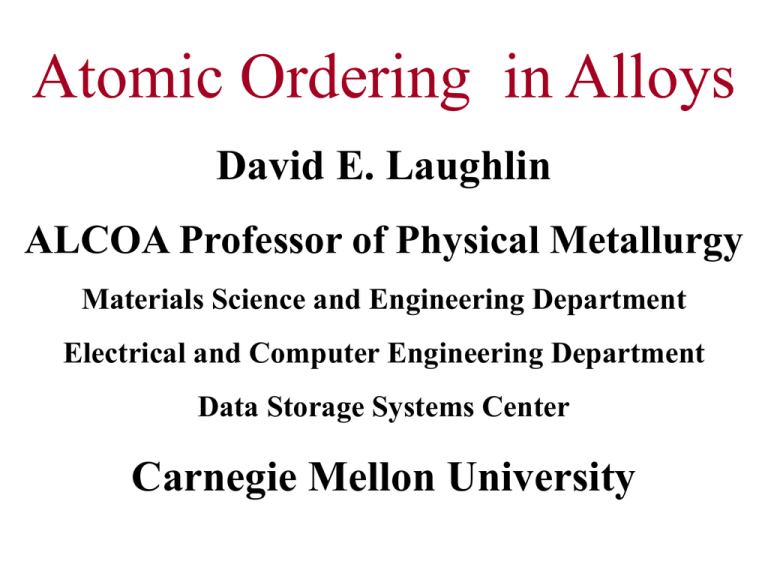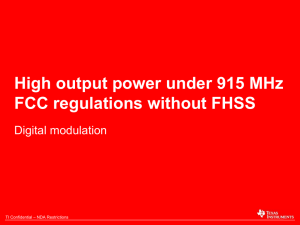Structural Domains - Materials Science and Engineering
advertisement

Atomic Ordering in Alloys David E. Laughlin ALCOA Professor of Physical Metallurgy Materials Science and Engineering Department Electrical and Computer Engineering Department Data Storage Systems Center Carnegie Mellon University The phrase disorder to order or order / disorder in alloys is an ambiguous term. Depending on your background it may mean different things. For example if I say “disordered alloy” some people think about an amorphous material as opposed to a crystalline one others about a random distribution of atoms on a crystal lattice as opposed to an ordered distribution and others about a paramagnetic alloy or paraelectric alloy! Today’s talk will focus on the ordering of two (or more) types of atoms on an underlying “lattice”. There will be some application to magnetic ordering as well! Topics of today’s talk include: order parameter and its measurement microstructure of the transformation crystallography and domains thermodynamics / kinetics Applications An atomic disorder to order transformation is a change of phase. It entails a change in the crystallographic symmetry of the high temperature, disordered phase, usually to a less symmetric low temperature atomically ordered phase. This can be understood from a basic equation of phase equilibria in the solid state, namely the definition of the Gibbs Free Energy: G = H - TS where G is the Gibbs free energy H is the enthalpy S is the entropy of the material G = H - TS At constant T and P the system in equilibrium will be the one with the lowest Gibbs Free Energy At high temperatures the TS term dominates the phase equilibria and the equilibrium phase is more “disordered” (higher entropy) than the low temperature equilibrium phase. Examples: Liquid to Solid Disorder to Order In both cases the high temperature equilibrium phase is more “disordered” than the low temperature “ordered” phase. A Phase Diagram Which Includes a Typical Disorder to Order Transformation High Temperature, disordered phase (FCC, cF4) Low Temperature, ordered phase (L10, tP4) Order Parameter When an disorder to order transformation occurs there is usually a thermodynamic parameter, called the order parameter, which can be used as a measure of the extent of the transformation. This order parameter, h, is one which has an equilibrium value, so that we can always write: G 0 h T , P since G, the Gibbs free energy is a minimum at equilibrium Order Parameter as a Function of T There are two distinct ways that L may vary L with temperature. This behavior is called a “first order” phase transition. At Tc the disordered and ordered phases may coexist. L There is a latent heat of transformation in this type of transformation. This behavior is called a “higher order” phase transition. At Tc the disordered and ordered phases do not coexist. L There is no latent heat of transformation in this type of transformation. The Order Parameter in Ferromagnetic Transitions is the Magnetization, M How Do We Measure the Atomic Order Parameter? We will do this for the easiest case or disorder to order, namely the BCC to CsCl transition BCC, A2 L=0 CsCl, B2 1L0 In the disordered case (BCC) the probability of an A atom being at the 000 site is the same as being at the ½½½ site. There are two equivalent sites per unit cell (of volume a3) in this structure In the ordered case (B2) the probabilities are not equal: there is a tendency for A atoms to occupy one site and B atoms to occupy the other site. In the fully ordered case, all the A atoms are on one type of site (e.g. 000) and all the B atoms are on the other type (e.g. ½ ½ ½ ) There is only one equivalent site per unit cell (of volume a3) in this structure. This is a loss in translational symmetry Using the following terms we can quantify the ordering: sit es : 000 111 sit es : 222 p is the probability of finding A on A p is the probability of finding B on B pA is the probability of finding A on pB is the probability of finding B on p p 1 A B p p 1 A B Fhkl f i e xp(2i( hu kv lw ) Structure factor , on the sites : pAf A pB f B on the sites : pAf A pB f B T hus Fhkl pAf A pB f B ( pAf A pB f B )(e xp(i( h k l)) Fhkl p f p f (p f p f )(exp(i(h k l)) A A B B B B Specific Cases: A A p A pA X A a) random p B pB X B Fhkl (X A f A X Bf B )[1 exp( i(h k l))] T hisis theBCC case : h k l odd Fhkl 0 h k l even Fhkl 2(X A f A X Bf B ) Fhkl (f A f B ) if X A X B 0.5 Intensity (%) 1,1,0 (44.35,100.0) 100 Diffraction Pattern of A2 or BCC Structure 90 80 70 60 50 40 2,1,1 30 (81.64,22.7) 2,0,0 (64.52,13.3) 20 10 2 q (°) 0 20 25 30 35 40 45 50 55 60 65 70 75 80 84 Fhkl p f p f (p f p f )(exp(i(h k l)) A A B B A A B B Specific cases: b) complete order p 1 p 0 A A pB 1 p B 0 Fhkl f A f B exp(i(h k l)) if h k l is odd Fhkl f A f B if h k l is even Fhkl f A f B Intensity (%) 1,1,0 (44.35,100.0) 100 90 Diffraction Pattern of B2 or CsCl Structure 80 Fhkl f A f B 70 60 Fhkl f A f B 50 40 1,0,0 30 2,1,1 (81.64,23.4) (30.96,25.2) 20 1,1,1 (55.06,5.3) 10 2,0,0 (64.52,13.5) 2,1,0 (73.27,5.3) 2 q (°) 0 20 25 30 35 40 45 50 55 60 65 70 75 80 84 Intensity (%) 1,1,0 (44.35,100.0) 100 90 80 A2 70 60 50 40 2,1,1 30 (81.64,22.7) 2,0,0 (64.52,13.3) 20 10 2 q (°) 0 Intensity (%) 20 25 30 35 100 40 1,1,0 45 50 (44.35,100.0) 55 60 65 70 75 80 84 90 80 Superlattice peaks, or reflections 70 60 50 B2 40 1,0,0 30 2,1,1 (81.64,23.4) (30.96,25.2) 20 1,1,1 (55.06,5.3) 10 2,0,0 (64.52,13.5) 2,1,0 (73.27,5.3) 2 q (°) 0 20 25 30 35 40 45 50 55 60 65 70 75 80 84 It can be shown that the intensity of a superlattice reflection is I = L2 F2 Thus the order parameter can be obtained from the relative intensities of the superlattice reflections L=0 L = 0.6 L=1 Intensity (%) Intensity (%) Intensity (%) 1,1,0 (44.35,100.0) 100 1,1,0 (44.35,100.0) 100 90 90 80 80 70 70 60 60 50 50 40 40 2,1,1 (81.64,22.7) 30 2,0,0 (64.52,13.3) 20 90 80 70 60 50 40 2,1,1 (81.64,23.4) 30 20 10 2,0,0 (64.52,13.5) 1,0,0 (30.96,9.1) 10 2 q (°) 0 25 30 35 40 45 50 55 60 65 70 75 80 84 1,0,0 30 2,1,1 (81.64,23.4) (30.96,25.2) 20 1,1,1 2,1,0 (55.06,1.9) (73.27,1.9) 1,1,1 (55.06,5.3) 10 2,0,0 (64.52,13.5) 2,1,0 (73.27,5.3) 2 q (°) 0 20 1,1,0 (44.35,100.0) 100 2 q (°) 0 20 25 30 35 40 45 50 55 60 65 70 75 80 84 20 25 30 35 40 45 50 55 60 65 70 75 80 84 The Long Range Order parameter is a macroscopic parameter, in that it is a measure for the entire sample that is examined by the xrays or electrons. It may or may not be homogeneous within the sample. We will now look at this is some detail. Broadly speaking there are two kinds of transformations that occur in materials: Homogeneous Heterogeneous In a homogeneous transformation the entire system (sample) transforms at the same time. All regions of the sample are transforming In a heterogeneous transformation there are regions which have transformed and regions which have not transformed Heterogeneous Ordering in an FePd Alloy From Klemmer Homogeneous Ordering Transformation of a Particle L = 0 < L < L < L < L < L =1 time The colors represent the degree of order in the grains. Note that the way the order is represented is homogeneous. Homogeneous Ordering Transformation of a Particle FePt L10 Particle Heterogeneous Ordering Transformation of a Particle FePt L10 Particle Heterogeneous and Homogeneous Ordering in Polycrystalline Sample L = 0.5 L = 0.5 The FCC to L1o Disorder to Order Transformation Intensity (%) Intensity (%) 1,1,1 (43.32,100.0) 100 100 90 90 80 80 70 70 60 1,1,1 (43.75,100.0) 60 tetragonal 2,0,0 50 50 (50.45,45.0) 40 2,0,0 40 2,2,0 (74.13,22.0) 30 (50.45,31.6) 3,1,1 30 (89.94,23.2) 20 20 2,2,2 10 (95.15,6.7) 1,1,0 (35.08,15.5) (90.24,18.5) 1,1,32,2,2 (51.99,14.3) 2,0,1 1,1,2 (74.13,8.3)2,2,1 3,1,0 (92.64,8.7) (96.36,8.0) (57.27,7.2) (64.27,4.9) (79.78,2.5) (84.73,2.2) 10 2 q (°) 0 3,1,1 2,0,2 (75.37,15.8) 2,2,0 0,0,2 2 q (°) 0 30 35 40 45 50 55 60 65 70 75 80 85 90 95 100 30 35 40 45 50 55 60 65 70 75 80 85 90 95 100 There are superlattice reflections from the ordering as well as split reflections due to the new tetragonal structure Since the lattice parameters and symmetry change during the transformation there will be changes in the diffraction pattern. 1 h k l 2 2 2 d a c 2 2 2 For the tetragonal phase The 111FCC reflection does not split, but the 200FCC reflection as well as others such as the 311FCC do split due to the tetragonality of the new phase. That is the 311L1o does not have the same d spacing as the 113L1o Intensity (%) 100 FCC 90 80 70 60 50 40 3,1,1 30 (89.94,27.1) 20 2,2,2 3,1,0 (84.73,2.1) 10 (95.15,7.9) 2 q (°) 0 80 85 90 95 98 Intensity (%) 100 L1o 90 80 If the transformation is discontinuous or heterogeneous, there will be a time during which both the FCC phase and L1o tetragonal phase is present 70 60 50 40 30 3,1,1 (90.24,18.5) 20 1,1,3 (92.64,8.7) 3,1,0 (84.73,2.2) 10 2,2,2 (96.36,8.0) 2 q (°) 0 80 85 90 95 98 Note the splitting in the 311 Note the two phase equilibria at 6 and 8 hr. The 311L10 increases in intensity and the 311FCC decreases. However the peak position does not change much showing that the initial L1o had pretty much the equilibrium composition and hence order parameter DISCONTINUOUS or Heterogeneous K1 and K2 observed because of the large 2q angle Here, the 311L10 increases in intensity and the 311FCC decreases. However the peak position changes continuously showing that the initial L1o was very similar to the FCC phase. No obvious two phase equilibrium CONTINUOUS or Homogeneous The Crystallography of the L10 Formation FCC (CoPt) Ordering Temp. < 825oC L10 CoPt Easy Axis c c a b b a Co or Pt Pt Co There are changes in the translational symmetry and in the point group symmetry FCC para FCC para to L1o para L1o-para 48/16 = 3 structural domains 4 to 2 eq. Sites = 2 orientation domains per structural domain L1o-ferro Co Pt 6 DOMAINS in TOTAL due to FCC to L10 Let’s first look at the translational domains Anti-phase translation C axis Anti-Phase Boundary Translation vector is 1/2 back and 1/2 up 1/2[101] Translational Domains (Anti-phase) FePd, after Zhang and Soffa Changes in the point group symmetry: Structural Domains The Three Structural Domains (Variants) of L1o Structural Domains (Variants) Translational Domains (Antiphase) FePd, after Zhang and Soffa Bo Bian FePt particle Phase diagram of FePd alloy Fe or Pd c-axis 3.852Å 3.723Å Fe Pd Structure of L10 materials Structural variants are formed due to symmetry breaking down. FCC-> L10 C3 axis Twin boundary C1 axis Fe Fe or Pd Pd Magnetic domains are formed when paramagnetic L10 phase transforms into Ferromagnetic phase. M M// c axis Magnetic domain wall Magnetic properties depends on the coupling between these two type of domains. Twin boundary =Magnetic domain wall Polytwinned microstructure Structural variants are formed due to symmetry breaking down. FCC-> L10 (011) C3 axis (101) C1 axis Three variants can form polytwinned structure to minimize the strain energy. C2 axis <111> C3 and C2 variants intersect at (011) twin boundary. C1 and C3 variants intersect at (101) twin boundary. C1 and C2 variants intersect at (110) twin boundary. (110) (111) (011) C2 variant (101) C3 variant C1 variant Micro-Magnetics in polytwinned microstructure Trace analysis can be used to determine the surface orientation of the polytwinned microstructure and the c axis orientation of the twin variants. [130] [120] Fresnel under-focus Fresnel over-focus Fresnel in-focus p[010] p[001] Surface normal [1, 7, 19] DW1 87.3o [010] 45.0o p[100] D(101) 25.4o C(101) Schematic diagram of magnetization directions [100] DW2 63.65o 70.4o A(011) B(110) C axis orientation projection In the plane of observation [001] 19.8o Surface orientation FCC t o L10 Disorder t oOrder G H - TS : when G 0 H TS S Sorder Sdisorder 0 T hus H TS 0 EXOT HERMIC DSC Traces and the Kissinger Plot for FePt (Barmak, Kim, Svedberg, Howard) -12.4 Tpeak (oC) 12 20 395 40 410 80 426 8 Q = 1.7 ± 0.1 eV -12.8 -13.2 2 16 (oC/min) ln(/Tp ) [1/Ks] Exotherm Down (mW) 20 4 -13.6 -14.0 -14.4 16.6 16.8 17.0 17.2 1/ (kBTp) [1/eV] 0 17.4 -4 Fe0.50Pt0.50 1000 nm -8 o 20 C/min o 40 C/min o 80 C/min -12 -16 0 * : Constant Heating Rate 100 200 300 400 500 o Temperature ( C) 600 700 DSC Traces and the Kissinger Plot for CoPt (Barmak, Kim, Svedberg, Howard) -12.8 20 517 40 531 80 544 Q = 2.8 ± 0.2 eV -13.2 2 Exotherm Down (mW) Tpeak (oC) ln(/Tp ) [1/Ks] (oC/min) 8 4 -13.6 -14.0 -14.4 -14.8 14.2 0 14.4 14.6 1/ (kBTp) [1/eV] Co0.45Pt0.55 1000 nm -4 o 20 C/min o 40 C/min o 80 C/min -8 0 100 200 300 400 500 o Temperature ( C) 600 700 DSC measurement of Curie Temperature FePd FCC and L10 455oC DSC scan of FePd with different composition Heat capacity (arbitrary unit) 0.55 0.5 Fe50Pd_FCC Fe50Pd_L10 0.45 Fe55Pd_FCC 0.4 Fe55Pd_L10 0.35 Fe60Pd_FCC 0.3 450oC 419oC Fe60Pd_L10 0.25 399oC 340oC 0.2 320oC 0.15 0.1 0.05 0 200 250 300 350 400 450 Temperature (oC) 500 550 600 M-T measurement of Tc for FePd FCC and L10 Fe-50, 55, 60 at%Pd M-T 1.2 1 50_FCC_1 Reletive moment 50_FCC_2 50_FCC_3 0.8 50_L10 55_FCC_1 0.6 55_FCC_2 55_L10 60_FCC_1 0.4 60_FCC_2 60_FCC_3 60_L10 0.2 0 200 250 300 350 400 o 450 500 550 Temperature ( C) Fe-50at.%Pd Fe-55at.%Pd Fe-60at.%Pd FCC 748 K (475oC) 698 K (425oC) 618 K (345oC) L10 723 K (450oC) 668 K (395oC) 593 K (320oC) Phase Diagram of FePd Curie temperature (Tc) of Ordered FePd alloy (L10). Phase diagram, ASM International FCC L10 on cooling C-Curve Kinetics of FePd Driving Force ~ HvT/Tc Tc Temperature Long time because of small T after Guschin, 1987 time After Klemmer Long time because of small amount of diffusion CrPt3 – Example of Order/Disorder Magnetic/NM Cr Magnetic (Ordered) a Pt Random Non-Magnetic (Disordered) a 3/4 Pt b 1/4 Cr b y x y x z c Order Parameter vs Ion Dose Magnetic Properties vs Ion Dose 7000 1.0 6000 150 0.8 0.6 0.4 5000 4000 100 3000 Ms Mr Hc 50 0.2 2000 1000 0 0.0 10 11 10 12 10 13 10 + 14 10 2 Ion Dose (B /cm ) 15 10 16 0 10 11 10 12 10 13 10 14 10 15 10 2 Ion Dose Density (1/cm ) 16 Hc (Oe) No Implant Mr,Ms (emu/cc) Long-Range Order Parameter, S z c Ordered Alloys with a Magnetic/Non-Magnetic Transition Alloy O Mag. -> D Non O Non -> D Mag. High -> Low Ms Tc < Room Temp Vanadium Alloys VPt3 Atomic Ordering Disordered Ordered Disordered Temp. (deg C) Structure Structure Magnetic Ordered Disordered Ordered Magnetic T c (deg C) T c (deg C) 1015 fcc L12 / D022 P F/F n/a -30 / -60 1130 570 fcc fcc L12 L10 P P I F n/a n/a ~ 200 350 505 fcc fcc L12 L12 P P F F n/a n/a 350 Manganese Alloys MnPt3 MnxAl1-xCy, tau 1000 850 fcc fcc L12 L10 P P F F n/a n/a 100 Iron Alloys FePt3 FeAl 1352 1310 fcc bcc L12 B2 F F A P Nickel Alloys NiPt Ni3Mn 645 510 fcc fcc L10 F F, low Ms A F, high Ms Chromium Alloys CrPt3 CrPd Cr2Pd3 (CrxMn1-x)Pt3 L12 -100 -158 L10 High Anisotropy Media Toward Ultra High Density of 1 terabits/inch2 C-axes FePt 001 001 fiber texture underlayer Si or Glass Grains Soft Magnetic Layer will be inserted Substrate Magnetic Hysteresis Perpendicular Anisotropy Small Grain magnetic isolation Minimizing FCC phase Lowering ordering Temperature Plan view TEM <001> 50nm c 50nm 55nm z yx b a 55nm 530 C deposition Average grain size ~10-15nm FePt ~ 9 nm MgO 8nm Glass In-plane XRD INTENSITY (a.u.) 55nm 110 20 30 200 40 50 60 70 Ordered FePt particles Questions: will very small size particles order? Can ordering occur without sintering?…etc. etc. Summary We have looked at several of the aspects of the atomic disorder to order phase change in alloys: Thermodynamics Phase Diagrams Transformations Kinetics Crystallography Diffraction Applications Now we will look at cases with V1 < 0 We start with BCC derivative structures We move onto FCC Derivative Structures Statistical Models for Solid Solutions After Lupis, Chemical Thermodynamics of Materials From statistical thermodynamics (for example Guggenheim’s text on Mixtures) we know that we can write: G F kT ln P where P g(Ek ) exp(E k ) uk Where P is the partition function, the sum is over all possible energy levels and = 1/kT g(Ek) is the degeneracy factor if the kth state, which is the number of states that have the same energy Thus in order to obtain expressions for the thermodynamic functions we need to know the energy levels and how the system is distributed over the energy levels, viz we need to know the: Hamiltonian (ENERGY) Distribution function (ENTROPY) The Excess Configurational Gibbs free energy of a partially ordered solid solution can be shown to be: G C H C TSC E C TSC Zn RT G C E(1 2 ) [2 ln 2 (1 ) ln(1 ) (1 ) ln(1 )] 2 2 1 where E (E AA E BB ) E AB 2 G C At equilibrium we know that 0 T hus aftersome algebra we obtain: (1 ) ZE ln (1- ) kT (here, 2n N 0 ) (1 ) 2 tanh1 ln (1- ) ZE 1 thus tanh y 2kT 2kT y ZE X ZE we plot tanh versus and lines through 2kT ZE theorigin with variousvaluesof y 2kT 1 The equilibrium order parameter l is determined by noting where the curve and the line intersect. l Critical temperature Temperature This represents a higher order transition. Just like the para to ferromagnetic transition Fhkl p f p f (p f p f )(exp(i(h k l)) A A B B A A B B Specific cases: c) incomplete order For h k l even Fhkl p f p f (p f p f ) A A B B A A B B Fhkl (p p )f A (p p )f B A A B B but p p 2X A and p p 2X B A A Fhkl 2(X A f A X B f B ) B B Fhkl p f p f ( p f p f )(exp(i(h k l)) A A B B A A B B For h k l odd Fhkl p f p f (p f p f ) A A B B A A B B which reduces to Fhkl (p p )(f A f B ) A A L (p p ) A A Fhkl =L(fA - fB) Kinetics How fast does a phase form This is often more important than what phase is the equilibrium one! I = K exp( -G*/kT) I is the rate of nucleation G* is barrier to nucleation (all precipitation reactions have a barrier to their initiation) Let us look at the form of this equation rate = K exp( -Q/kT) as T increases, the rate increases or as Q decreases, the rate increases Q is called activation energy The equation is Arrhenius’ law Typical plots are as shown below The slope is -Q/k 1/T Another important equation that has this form is the one for the temperature dependence of the diffusion coefficient QD D D O exp( ) RT Here, QD is the activation energy for diffusion which in substitutional solid solutions is usually the sum of the activation energies of the formation of vacancies and the motion of vacancies Time-Temperature-Transformation Time T No transformation Transformation nearly complete The lower region follows Arrhenius’ law. Why not the upper? Look at the nucleation rate equation I = K exp( -G*/kT) As the temperature approaches the transition temperature, g* gets larger and larger because it is equal to G* = 16 s3 / 3 gv2 and gv goes to zero at the transition temperature Time-Temperature-Transformation Time T No transformation Importance of quench rate Knee of the curve, etc Transformation nearly complete X 1 exp((kt) ) n This equation is sometimes called the Johnson/Mehl/ Avrami equation X 1 exp((kt) n ) dX T hus nkn t n 1 (1 X) dt Note that for t = 0, the rate is zero and for large t, the rate goes to zero as well. A maximum exists with respect to time. Back to the Nucleation rate equation G* = 16 s3 / 3 gv2 Note the importance of the surface energy term, s and the driving force term, Gv Let us look at gv How do we obtain this value? From the Free Energy Curves! Note that the value of gv is largest for the more stable phase. At first sight it looks like this means that the barrier to nucleation is smallest for the stable phase. BUT we must look at the surface energy term! This term comes in as a cubic. This is the secret to why less stable phases form faster than stable ones! It is almost always because the surface energy term of the less stable is smaller than that of the stable phase. Hence the value of the barrier to nucleation, g* is smaller!







